I first tasted Razon's Halo-Halo during a hot summer visit to my relatives in Pampanga. My Tita Delie brought me to this small shop in Guagua, and I remember being surprised their halo-halo looked so simple compared to the loaded ones I grew up eating in Manila.
But that first taste changed everything! Just four ingredients: sweet banana, macapuno strings, creamy milk over shaved ice, and silky leche flan on top. No beans, no gulaman, no kaong. But trust me, it was the best halo-halo I've ever had.
My Tita Delie taught me her version of this famous Pampanga dessert. And after making it countless times at home, I'm excited to share this special recipe with you. It's surprisingly easy to make, and the flavors will transport you straight to that famous shop in Guagua. Perfect for our hot Philippine weather.
Cultural Notes
Halo-halo is more than just a dessert in Filipino culture; it's a beloved tradition that brings people together. Razon's version revolutionized this dessert by proving that simplicity can be extraordinary. While traditional halo-halo often features a dozen or more ingredients, Razon's minimalist approach focuses on quality over quantity, creating a perfect harmony of flavors and textures.
Jump to:

Why You'll Love This Recipe
- Authentically minimalist approach compared to traditional loaded halo-halo
- Perfect balance of textures and flavors
- Easy to prepare with minimal ingredients
- Refreshing for hot days
- Rich cultural heritage from Pampanga
- Customizable sweetness levels
- Make-ahead friendly components
Ingredients
This minimalist selection creates the perfect Filipino dessert experience. The caramelized saba bananas provide natural sweetness and soft texture, while macapuno adds chewy coconut goodness.
Ultra-fine shaved ice creates the signature melt-in-your-mouth base, evaporated milk adds rich creaminess that binds everything together, and the silky leche flan crowns the dessert with luxurious custard flavor.
Unlike traditional halo-halo with many competing flavors, these few ingredients create perfect harmony in every spoonful.
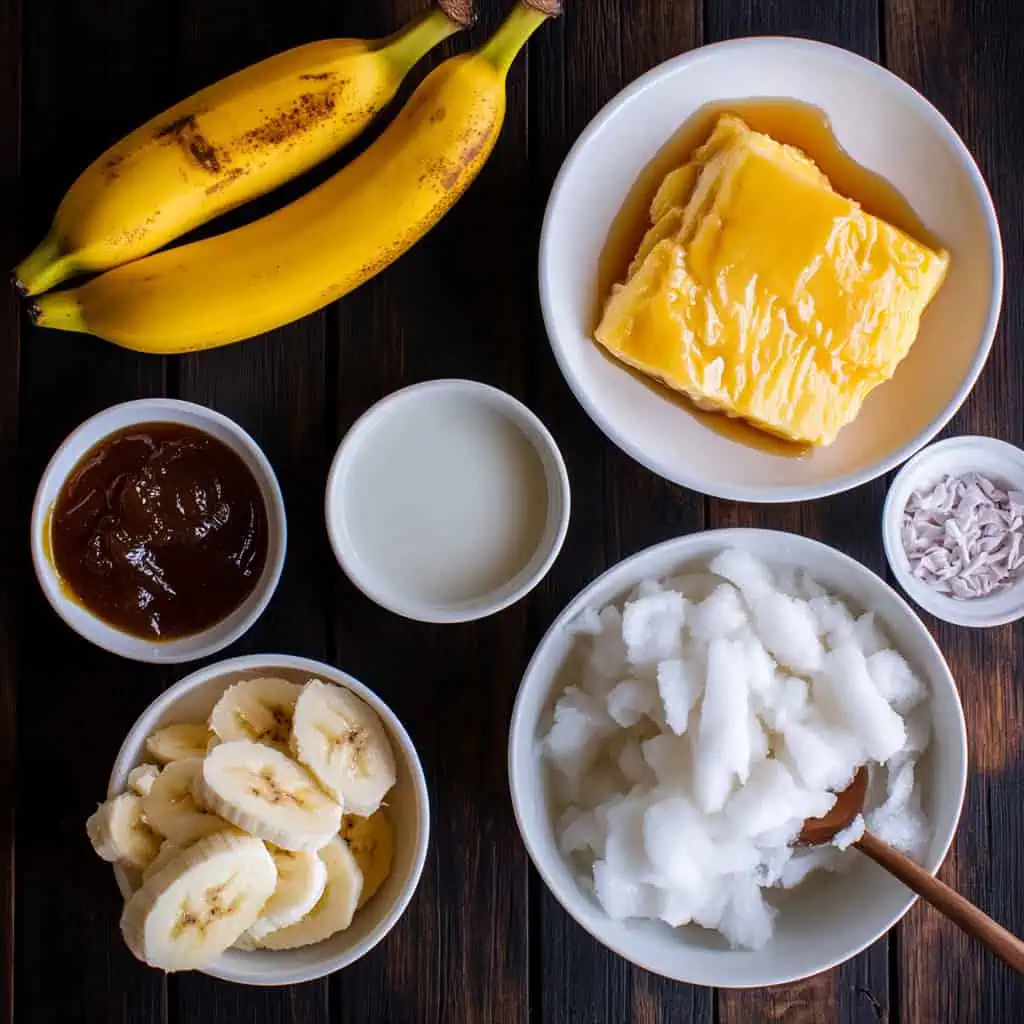
- 2 cups coco jam (coconut jam/matamis na bao)
- ⅓ cup water
- 2 ripe saba bananas or regular bananas, diced small
- 8 tablespoons macapuno coconut sport strings/bukayo
- 8 cups shaved ice
- 1 cup evaporated milk
- 1 llanera leche flan
- Optional: Calamansi rind for garnish
Equipment
- Shave ice machine or blender: For creating fine, snow-like ice texture. A dedicated shave ice machine produces the best results, but a good blender can work in a pinch.
- Heavy-bottom saucepan: For caramelizing bananas. The thick base prevents burning and ensures even heat distribution.
- Glass bowls or tall glasses (10-16 oz): Traditional serving vessels that showcase the beautiful layers.
- Ice cream scoop or spoon: For portioning ingredients evenly across servings.
- Measuring cups and spoons: For precise measurements to maintain the perfect balance of flavors.
- Sharp knife: For slicing bananas and leche flan cleanly.
- Cutting board: For preparation work.
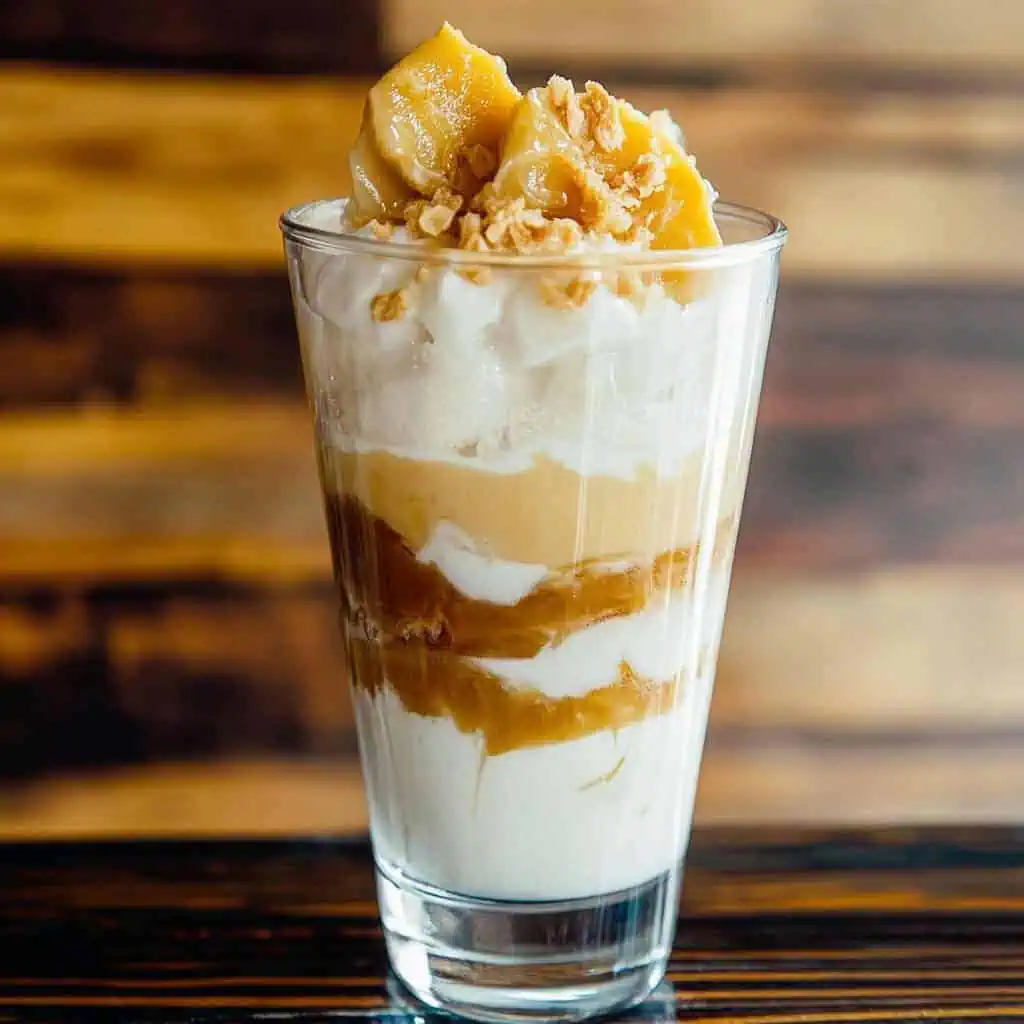
How To Make
- Start by making your caramelized bananas. Pour 2 cups of coco jam and ⅓ cup water into a saucepan. Heat this mixture over medium heat until it starts to bubble, which takes about 3 minutes. Once bubbling, turn off the heat and add your diced bananas. Stir everything together gently, then pour this mixture into a bowl and let it cool completely.
- While waiting for your banana mixture to cool, slice your leche flan into portions and prepare your shaved ice. Once your bananas have cooled to room temperature, you can start building your halo-halo.
- Take your serving glass and spoon 2 tablespoons of the cooled caramelized bananas into the bottom. Add a tablespoon of macapuno strings on top of the bananas. Now fill your glass with about 2 cups of finely shaved ice, packing it down gently. Pour evaporated milk generously over the ice until it seeps through to the bottom. Place three slices of leche flan on top of the ice. If you'd like, grate some fresh calamansi rind over the flan for extra flavor.
- Serve your halo-halo right away while the ice is still frozen. When you're ready to eat, mix everything together to combine all the flavors.

Tips from Lola's Kitchen
- Use extremely ripe saba bananas for natural sweetness. Look for bananas with black spots on the skin – this indicates they've reached peak sweetness.
- Chill serving glasses beforehand for slower ice melting. Place them in the freezer for about 15 minutes before serving.
- Shave ice as finely as possible for the authentic texture. The ice should be almost snow-like in consistency.
- Don't skimp on the evaporated milk. The creaminess is essential to balance the sweetness of the other ingredients.
- For the most authentic experience, use a traditional "Yelo" machine to shave the ice. This creates the signature fine texture that Razon's is known for.
- Layer ingredients in the correct order. The bananas and macapuno go at the bottom so they can mix with the melting ice and milk.
- Make leche flan a day ahead for better texture. It will be firmer and easier to slice.
Substitutions
- Saba Bananas: If you can't find saba bananas, use very ripe regular bananas or plantains. Choose ones that are very sweet and soft.
- Coco Jam: You can substitute with brown sugar syrup mixed with coconut milk. Cook 1 cup brown sugar with ½ cup coconut milk until thick.
- Macapuno: Young coconut strips or nata de coco can work as alternatives, though the texture will be different.
- Evaporated Milk: Fresh milk, coconut milk, or a blend of condensed and regular milk can be used.
- Leche Flan: Custard pudding or crème caramel make good substitutes if you don't have time to make traditional leche flan.
- Shaved Ice: In a pinch, crushed ice can work, though the texture won't be as authentic.
Troubleshooting
- Ice melting too quickly?
- Use pre-chilled components for all ingredients
- Serve in chilled glasses
- Add extra ice if needed
- Work quickly during assembly
- Banana mixture too thick?
- Add small amounts of hot water while cooking (1 tablespoon at a time)
- Stir constantly while heating to prevent burning
- Make sure to use the correct ratio of coco jam to water
- Leche flan breaking apart?
- Ensure it's properly chilled (at least 4 hours, preferably overnight)
- Use a sharp knife dipped in hot water for clean cuts
- Handle gently during transfer to the glass
- Cut into appropriately sized pieces for your serving glasses
- Not sweet enough?
- Add a small amount of condensed milk along with the evaporated milk
- Make sure your bananas are fully ripe
- Adjust the sweetness of your coco jam mixture
Storage & Reheating
- Store components separately for best results.
- Caramelized bananas: Refrigerate in an airtight container for up to 5 days. Bring to room temperature before using.
- Leche flan: Refrigerate covered for up to 3 days. The texture may change slightly but will still be delicious.
- Macapuno: Keep refrigerated in its original syrup in an airtight container for up to 2 weeks.
- Assembly: Halo-halo is best enjoyed fresh. Pre-assembled servings are not recommended for storage as the ice will melt and change the texture and flavor balance.
- No reheating required: All components are served cold. If components are too cold from refrigeration, let sit at room temperature for 5-10 minutes before assembly.

FAQ
Can I make this without a shave ice machine?
While not ideal, you can use a blender to crush ice finely. Wrap ice cubes in a clean kitchen towel and smash them first, then pulse in a blender until very fine. The texture won't be as authentic, but it will still be delicious.
How ripe should the saba bananas be?
They should be very ripe with black spots on the skin. This ensures maximum sweetness and the perfect soft texture when caramelized.
Can I prepare components ahead of time?
Yes, all components except the shaved ice can be prepared 1-2 days ahead and stored separately in the refrigerator. This makes assembly quick and easy when you're ready to serve.
Why is my leche flan breaking apart?
Ensure it's properly chilled and use a sharp, hot knife for cutting. You might also need to adjust your leche flan recipe to create a firmer texture, try reducing the amount of liquid or increasing the egg yolks.
Is this the exact Razon's recipe?
This is a close homage to their famous recipe, adapted for home cooking while maintaining the essence of their minimalist approach. The exact recipe is a closely guarded secret, but this version captures the spirit and flavors.
How do I know if my ice is shaved finely enough?
Properly shaved ice should look almost like snow—light, fluffy, and fine. It should melt quickly on your tongue and shouldn't have crunchy bits.
Can I add other ingredients to make it more like traditional halo-halo?
You can, but then it wouldn't be a Razon's style halo-halo! The beauty of this recipe is in its simplicity. If you want to try a hybrid version, add just one or two additional ingredients that complement the existing flavors.
What type of milk did the original Razon's use?
The original Razon's is believed to use a special blend of milk, but good quality evaporated milk comes closest to replicating their signature creamy taste.
How do I transport this for a gathering?
Transport all components separately in coolers or insulated containers. Bring the ice in an insulated ice chest, and assemble just before serving. You might want to bring extra ice in case some melts.
Can I make this vegan?
Yes! Substitute the evaporated milk with coconut milk, and make a vegan leche flan using coconut milk, agar-agar, and silken tofu. The banana and macapuno components are already plant-based.
Related
Looking for other recipes like this? Try these:
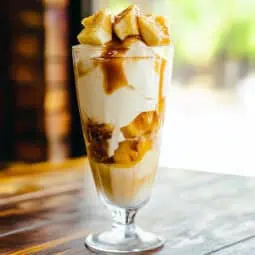
Razon's Halo-Halo Copycat Recipe
Equipment
- Shave ice machine (Yelo machine) For creating fine, snow-like ice texture
- Heavy-bottom saucepan (Kaserola) For caramelizing bananas
- Glass bowls or tall glasses (10-16 oz) Traditional serving vessels
- Ice cream scoop or spoon (Kutsara) For portioning ingredients
- Measuring cups and spoons (Panukat) For precise measurements
- Sharp knife (kutsilyo) For slicing bananas and leche flan
- Cutting board (Tablas) For preparation work
Ingredients
- 2 cups coco jam Coconut jam/Matamis na bao
- ⅓ cup water Tubig
- 2 ripe saba bananas or regular bananas Saging na saba, diced small
- 8 tablespoons macapuno coconut sport strings/Bukayo
- 8 cups shaved ice Yelong durog
- 1 cup evaporated milk
- 1 llanera leche flan
- Optional: Calamansi rind for garnish
Instructions
- Start by making your caramelized bananas. Pour 2 cups of coco jam and ⅓ cup water into a saucepan. Heat this mixture over medium heat (katamtamang init, 180°C/350°F) until it starts to bubble, which takes about 3 minutes. Once bubbling, turn off the heat and add your diced bananas. Stir everything together gently, then pour this mixture into a bowl and let it cool completely.
- While waiting for your banana mixture to cool, slice your leche flan into portions and prepare your shaved ice. Once your bananas have cooled to room temperature, you can start building your halo-halo.
- Take your serving glass and spoon 2 tablespoons of the cooled caramelized bananas into the bottom. Add a tablespoon of macapuno strings on top of the bananas. Now fill your glass with about 2 cups of finely shaved ice, packing it down gently. Pour evaporated milk generously over the ice until it seeps through to the bottom. Place three slices of leche flan on top of the ice. If you'd like, grate some fresh calamansi rind over the flan for extra flavor.
- Serve your halo-halo right away while the ice is still frozen. When you're ready to eat, mix everything together to combine all the flavors (Haluin ang lahat ng sangkap).
Tips from Lola's Kitchen
- Use extremely ripe saba bananas for natural sweetness
- Chill serving glasses beforehand for slower ice melting
- Shave ice as finely as possible for the authentic texture
- Don't skimp on the evaporated milk
- Keep components cold until assembly
- Make leche flan a day ahead for better texture
Nutrition
The Story Behind Razon's Famous Halo-Halo
Before there was Razon's, Filipino halo-halo was always about abundance – the more ingredients, the better. Traditional halo-halo stands would proudly display rows of sweet beans, jellies, fruits, and other mix-ins. But in the 1970s, a small shop in Guagua, Pampanga changed everything by breaking this golden rule.
Razon's started as a humble stall in Pampanga, a province famous for its incredible food and talented cooks. Instead of following the "everything but the kitchen sink" approach, they did something revolutionary. They created a halo-halo with just four perfect ingredients: caramelized saba bananas, sweet macapuno strings, creamy milk over shaved ice, and their signature leche flan on top. People thought they were crazy at first, how could halo-halo be good with so few ingredients?
But word spread quickly about this different kind of halo-halo. People started making special trips to Guagua just to try it. The secret wasn't in the number of ingredients, but in how each component was carefully prepared. Their saba bananas had to be perfectly ripe and caramelized just right. The macapuno needed to have that special stringy texture. The ice had to be shaved so finely it melted like snow in your mouth. And that leche flan on top? It became their signature finish.
Today, you can find Razon's branches all over the Philippines – from Manila to Cebu – and even in the UAE. They've grown from that small shop in Pampanga into a beloved dessert chain. But locals will tell you that nothing beats the original store in Guagua, where families still line up on hot afternoons for their famous minimalist halo-halo.
What makes this dessert special isn't just its taste, but how it challenged what everyone thought they knew about Filipino desserts. It proved that sometimes, doing less – but doing it perfectly – creates something even more memorable. Razon's Halo-Halo isn't just a dessert; it's a Pampanga innovation that changed Filipino dessert history, one simple, perfect bowl at a time.
Want to know what makes this recipe extra special? The beauty of Razon's Halo-Halo lies in its simplicity – each ingredient has to be perfect because there's nowhere to hide. This homemade version lets you recreate that famous Pampanga treat right in your own kitchen, using the same principles that made the original so legendary.
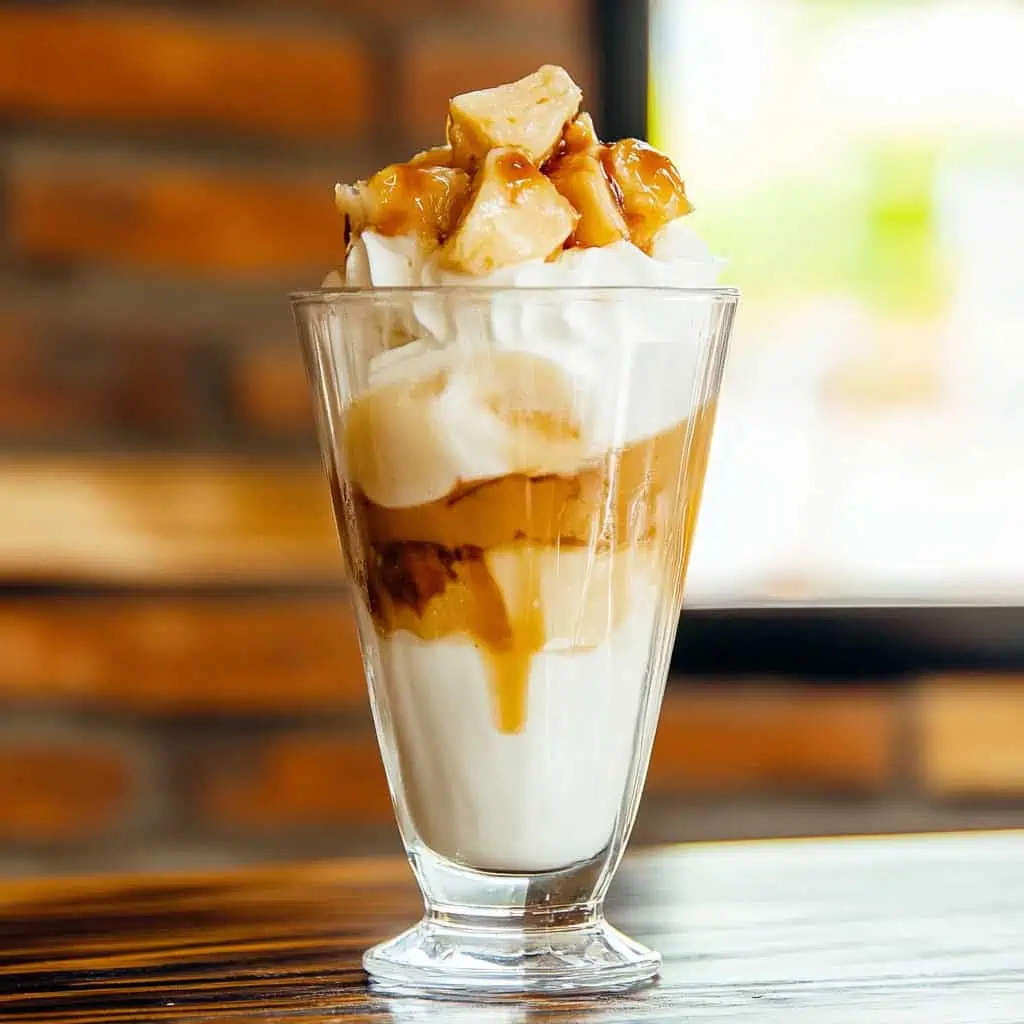






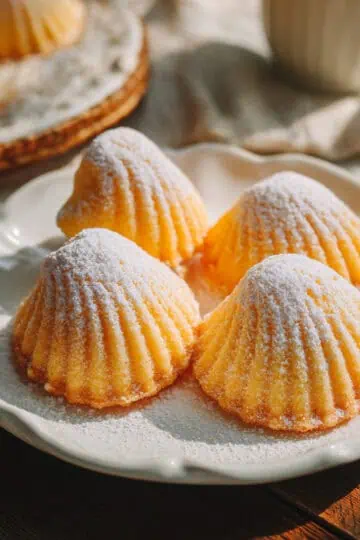
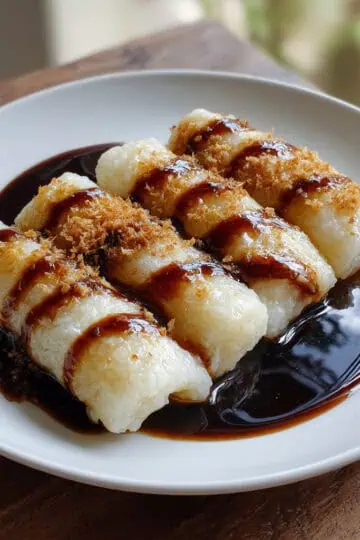
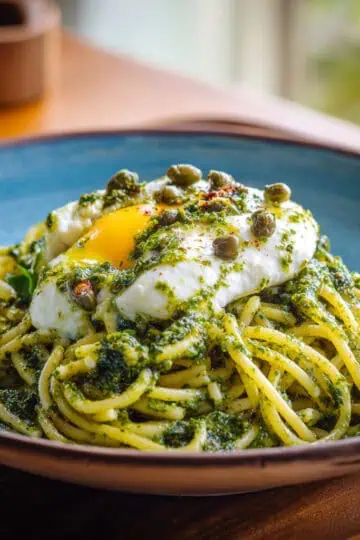
Comments
No Comments